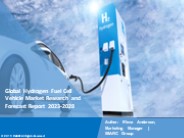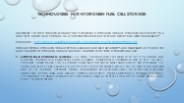Hydrogen Fuel Cell Industry PowerPoint PPT Presentations
All Time
Recommended
The adoption of U.S. Europe And Asia Industrial Hydrogen Market cells is on the rise across various industries such as automotive, power generation, and stationary power applications. Industrial hydrogen is essential for the efficient functioning of these fuel cells. The growing investment in research and development activities to enhance the performance and reduce the cost of hydrogen fuel cells is boosting the demand for industrial hydrogen.
| PowerPoint PPT presentation | free to download
Research projects that the Hydrogen Fuel Cell Hydrogen Tank market size will grow from XXX in 2019 to XXX by 2025, at an estimated CAGR of XX. The base year considered for the study is 2019, and the market size is projected from 2020 to 2025.
| PowerPoint PPT presentation | free to download
According to the latest research report by IMARC Group, The global hydrogen fuel cell vehicle market size reached US$ 1,130.9 Million in 2022. Looking forward, IMARC Group expects the market to reach US$ 12,324.9 Million by 2028, exhibiting a growth rate (CAGR) of 45.11% during 2023-2028. More Info:- https://www.imarcgroup.com/hydrogen-fuel-cell-vehicle-market
| PowerPoint PPT presentation | free to download
The global hydrogen fuel cells market size is expected to grow from $3.85 billion in 2021 to $5.58 billion in 2022 at a compound annual growth rate (CAGR) of 44.7%.
| PowerPoint PPT presentation | free to download
The Global and Chinese Hydrogen FuelCell Electric Vehicles Industry, 2012-2022 Market Research Report is a professional and indepth study on the current state of the global Hydrogen FuelCell Electric Vehicles industry with a focus on the Chinese market. The report provides key statistics on the market status of the Hydrogen FuelCell Electric Vehicles manufacturers and is a valuable source of guidance and direction for companies and individuals interested in the industry Visit here-https://www.grandresearchstore.com/automotive-and-transportation/global-and-chinese-hydrogen-fuel-cell-electric-veh
| PowerPoint PPT presentation | free to download
Hydrogen Fuel Cell market is forecast to reach $45.34 billion by 2025, after growing at a CAGR of 65.86% during 2020-2025.
| PowerPoint PPT presentation | free to download
Automotive fuel cell market size was estimated at over 5,000 units in 2015, and is expected to grow at a CAGR of 12.7% from 2016 to 2023. Growing consciousness regarding harmful emissions from gasoline and conventional fuel vehicles is expected to drive the industry over the forecast period.
| PowerPoint PPT presentation | free to download
Hydrogen Fuel Cell Market By Type (Proton Exchange Membrane Fuel cells, Phosphoric Acid Fuel Cells, Solid Oxide Fuel Cells, Molten Carbonate Fuel Cells, Others), By Application (Stationary, Transportation, Portable), By End User (Fuel Cell Vehicles, Utilities, Defense) and region (North America, Europe, Asia-Pacific, Middle East and Africa and South America)
| PowerPoint PPT presentation | free to download
The Global Hydrogen Fuel Cell Recycling Market is expected to grow at a CAGR of 14.20% in terms of revenue, over the forecast period of 2024-2032. Read More
| PowerPoint PPT presentation | free to download
Hydrogen Fuel Cells An Info 8 Assignment by Tom Linaker Hydrogen Fuel Cells An Info 8 Assignment by Tom Linaker A fuel cell would be more convenient than a regular ...
| PowerPoint PPT presentation | free to view
Hydrogen Fuel Cell market is forecast to reach $45.34 billion by 2025, after growing at a CAGR of 65.86% during 2020-2025.
| PowerPoint PPT presentation | free to download
Hydrogen fuel cell recycling market is a rapid adoption of hydrogen fuel cells across various industries shows the critical need for optimal recycling solutions
| PowerPoint PPT presentation | free to download
Hydrogen fuel cell technology is poised for significant advancements by 2025, with notable developments in the automotive and data center sectors:
| PowerPoint PPT presentation | free to download
The study segments Hydrogen Fuel Cell industry in light of major classification such as product type, potential markets, application, and end-user.
| PowerPoint PPT presentation | free to download
Hydrogen Fuel Cells Alternative Energy Source ... To be stored for cars it must be in liquid form, which defies its natural gaseous state.
| PowerPoint PPT presentation | free to view
One element of the hydrogen economy that is essential is hydrogen storage. Hydrogen must be kept in a solid state, under high pressure, or at low temperatures due to its low density and great flammability.
| PowerPoint PPT presentation | free to download
A newly published report by Market Statsville Group (MSG), titled Global Hydrogen Fuel Cell Market provides an exhaustive analysis of significant industry insights and historical and projected global market figures. MSG expects the global Hydrogen Fuel Cell market will showcase an impressive CAGR from 2024 to 2033.
| PowerPoint PPT presentation | free to download
Hydrogen fuel cells are coming under more and more attention as a potential replacement for conventional fossil fuels in the race for a sustainable future. The need to switch to renewable energy sources is more important than ever as worries about climate change and environmental damage grow. In this quest, hydrogen fuel cells future show promise as a means of achieving a more sustainable and environmentally friendly future.
| PowerPoint PPT presentation | free to download
... a battery the reaction is sustained as long as the cell is being ... be made to be small enough to power a cellular phone or large enough to power a town. ...
| PowerPoint PPT presentation | free to download
Types of Fuel Cell MEMS Labs MEM Departmemt NSYSU MEM Department NSYSU S.S. Hsieh ppt. 15 45-60 800-1000OC ( 1500-1800OF ) atmospheric oxygen hydrogen, ...
| PowerPoint PPT presentation | free to download
Hydrogen fuel cells are coming under more and more attention as a potential replacement for conventional fossil fuels in the race for a sustainable future. The need to switch to renewable energy sources is more important than ever as worries about climate change and environmental damage grow. In this quest, hydrogen fuel cells future show promise as a means of achieving a more sustainable and environmentally friendly future.
| PowerPoint PPT presentation | free to download
Hydrogen fuel cell vehicle market
| PowerPoint PPT presentation | free to download
The global hydrogen fuel cell vehicle (HFCV) market size is expected to reach USD 28.82 billion by 2026 according to a new study by Polaris Market Research. The report “Hydrogen Fuel Cell Vehicle Market Share, Size, Trends, Industry Analysis Report By Technology (Proton Exchange Membrane Fuel Cell, Alkaline Fuel cell, Solid Oxide Fuel Cell); By Vehicle Type (Commercial Vehicle, Passenger Car); By Regions, Segments & Forecast, 2020 – 2026” gives a detailed insight into current market dynamics and provides analysis on future market growth.
| PowerPoint PPT presentation | free to download
Hydrogen fuel cells hold immense potential for a wide range of applications in the future, offering clean and sustainable energy solutions across various sectors.
| PowerPoint PPT presentation | free to download
In an era marked by pressing environmental concerns and a growing need for sustainable energy solutions, the Hydrogen Fuel Cell Future shines as a beacon of hope for a cleaner, greener tomorrow.
| PowerPoint PPT presentation | free to download
The basic principle is the reverse reaction of electrolysis of water; hydrogen and oxygen were supplied to the cathode and anode, hydrogen diffusion through the cathode and the electrolyte reaction, the release of electrons through the external load to reach the anode.
| PowerPoint PPT presentation | free to download
Hydrogen and Fuel Cells in South Carolina: Strength in Collaboration Name Organization Date
| PowerPoint PPT presentation | free to view
Hydrogen Fuel Cell Cars: The Best Solution? Tim Cahill and Ryan Saran * Tesla Roadster A Hydrogen car uses hydrogen as its on-board fuel for motive power.
| PowerPoint PPT presentation | free to view
According to the latest research report by IMARC Group, The global hydrogen fuel cell vehicle market size reached US$ 1,641.0 Million in 2023. Looking forward, IMARC Group expects the market to reach US$ 37,320.9 Million by 2032, exhibiting a growth rate (CAGR) of 40.67% during 2024-2032. More Info:- https://www.imarcgroup.com/hydrogen-fuel-cell-vehicle-market
| PowerPoint PPT presentation | free to download
The global Hydrogen Fuel Cell market was valued at USD 10.49 Billion in 2018 and is projected to grow at a CAGR of 21.4% from 2019 to reach USD 49.52 Billion by the year 2026.
| PowerPoint PPT presentation | free to download
Hydrogen Fuel Cell Market
| PowerPoint PPT presentation | free to download
Hydrogen Fuel Cell Market: Segmentation by Type (Proton Exchange Membrane Fuel Cell, Phosphoric Acid Fuel Cell, Alkaline Fuel Cell, Solid Oxide Fuel Cell, Direct Methanol Fuel Cell, Molten Carbonate Fuel Cell, Microbial Fuel Cell), by Application (Transport, Portable, and Stationary), by End-Use (Vehicles, Utilities, and Defense), and by Region – Global Industry Sizing, Growth, Trend, Opportunity, and Forecast (2020–2025) The hydrogen fuel cell market report covers a thorough analysis of the market dynamics, business models, segmental/regional analysis, and respective market shares and strategies adopted by the key market players operating globally. It entails an in-depth analysis of the factors influencing the global market and market statistics indicating region wise and segment-wise market share/growth analysis. The report's study will outlook one of the most exhaustive
| PowerPoint PPT presentation | free to download
Hydrogen Fuel Cells Market - Global Industry Analysis, Size, Share, Growth, Trends, and Forecast 2016 - 2024
| PowerPoint PPT presentation | free to download
The global fuel cell electrolyte market can be segregated into proton-conducting membrane, caustic potash solution, concentrated phosphoric acid, molten carbonate and ceramic. Proton-conducting membrane electrolyte is essentially used in direct methanol fuel cell (DMFC) and polymer electrolyte membrane (PEM) fuel cells. Proliferating application of these fuel cells in vehicles, small appliances, block-type heat, small generators, block type heat and power stations are anticipated to drive the industry demand. Request for an in-depth table of contents for this report @ https://www.gminsights.com/request-toc/upcoming/224
| PowerPoint PPT presentation | free to download
GM Chevy Equinox. Fuel Cell. Compressed hydrogen. Technology: Fuel cell ... GM Chevy Equinox FC. GM Chevy Volt. HYDROGEN CARS (cont.) GM Electrovan. GM H2H Hummer SUT ...
| PowerPoint PPT presentation | free to view
Energy Sets the Scene. Setting the Scene for Fuel Cells: ... Stark State College of Technology Dorey Diab. Hocking College. Catacel Bill Whittenberger ...
| PowerPoint PPT presentation | free to view
The new Fuel Cell Market report offers a comprehensive study of the present scenario of the market coupled with major market dynamic. Also, it highlights the in-depth market analysis with the latest trends, drivers and its segments with respect to regional and country. Further, this report profiles top key players of the fuel cell and analyze their market share, strategic development and other development across the globe.
| PowerPoint PPT presentation | free to download
Fuel Cells An Emerging High-Technology Industry Rodger McKain, PhD 4/22/2006 Setting the Scene for Fuel Cells: Petroleum supply, consumption, and imports, 1970-2025 ...
| PowerPoint PPT presentation | free to view
Electric Energy: the Potential Showstopper for a Hydrogen Fuel-Cell Fleet Paul Kruger Stanford University Stanford, CA 94305 Topics The Human Quest for Abundant ...
| PowerPoint PPT presentation | free to download
Global Hydrogen and Fuel Cells Market Research Report 2017
| PowerPoint PPT presentation | free to download
The global Hydrogen Fuel Cell market was valued at USD 10.49 Billion in 2018 and is projected to grow at a CAGR of 21.4% from 2019 to reach USD 49.52 Billion by the year 2026.
| PowerPoint PPT presentation | free to download
A fuel cell converts chemical energy into electrical energy through an electromechanical reaction. A typical fuel cell consists of two electrodes, the anode and the cathode, which react to generate electricity.
| PowerPoint PPT presentation | free to download
The United States Fuel Cells Industry 2016 Market Research Report is a research study available at DecisionDatabases.com. The report studies the market, its value chain, latest trends, forecasts, innovation, drivers, and restraints. It’s a complete guide for the industry knowledge. Visit Us - http://www.decisiondatabases.com/ip/4965-united-states-fuel-cells-industry-market-report
| PowerPoint PPT presentation | free to download
Big Market Research “Stationary Fuel Cell Market” Size, Share, Industry Trends, Demand, Insights, Analysis, Research, Report, Opportunities, Company Profiles, Forecast to 2017. Visit for more info @ http://www.bigmarketresearch.com/stationary-fuel-cell-shares-strategies-and-forecasts-worldwide-2011-to-2017-market Global demand for stationary fuel cells is projected to increase from $122.9 million in 2010 to $2.6 billion in 2017. Growth of stationary fuel cells is a function of the need to harness intermittent energy generated from renewable wind and solar energy sources. By using stationary fuel cells to address issues relating to intermittency an end to end energy system is achieved.
| PowerPoint PPT presentation | free to download
This report studies Hydrogen and Fuel Cells in Global market, especially in North America, Europe, China, Japan, Southeast Asia and India, focuses on top manufacturers in global market, with production, price, revenue and market share for each manufacturer, covering Ballard Power Systems Inc (BLDP) Check complete report @ http://www.marketintelreports.com/report/qyr0164/global-hydrogen-and-fuel-cells-market-research-report-2016
| PowerPoint PPT presentation | free to download
Hydrogen refueling station, Chino, CA. Teams are Fielding. Four Main Types of Vehicles ... Chino, CA. LAX refueling station. Photo: H2CarsBiz. Photos: DTE. DTE ...
| PowerPoint PPT presentation | free to download
Coordinate hydrogen activities, including outreach and publications with the SEO, ... 35 million increase for Hydrogen Fuel Initiative ...
| PowerPoint PPT presentation | free to view
Stationary Fuel Cells: over 80%(including heat) ... (China), Universit Bordeaux 1 (France) , National University of Singapore ...
| PowerPoint PPT presentation | free to view
... of fuel cells Low temperature acid FCs Phosphoric acid fuel cell Operates at 130-2000C CO tolerance ... - Fuel cell based power packs with all ...
| PowerPoint PPT presentation | free to view
Request for a sample of this research report @ https://www.fractovia.org/request-sample/121 The global automotive fuel cell market size was projected at more than 5000 units and is predicted to register CAGR of 12.7% during the forecasted period. Using fuel cell technology in automotives will generate new jobs and build new sources of revenue generation. It has a great potential to change the market dynamics in resource intensive industry. The technology is also becoming cost effective and will be commercially feasible for mass use in automobiles like cars by 2025. Daimler, Nissan, Toyota, Hyundai, Honda, Ford and General Motors are all developing fuel cell automobiles. All these factors have contributed to the overall growth of the market. But the technology has been lagging owing to high operating costs and lack of infrastructure. It is a feasible choice to other zero emission automobile technologies.
| PowerPoint PPT presentation | free to download
To promote competitive markets in the UK and beyond. ... If produced sustainably, hydrogen can address each of these aspects. ...
| PowerPoint PPT presentation | free to view
Microbial fuel cell is a bio-electrochemical device that uses bacteria as the catalysts to oxidize organic and inorganic matter and generate current. Also, microbial is a fuel cell which transforms chemical energy into electricity using oxidation reduction reactions. MFC consists of an two electrodes (anode and cathode) and membrane (a area that separates two electrodes).
| PowerPoint PPT presentation | free to download
Fuel Cell Market Research Report - Industry Analysis, Size, Share, Growth, Trends and Forecast, 2014 - 2021. The research study Global Fuel Cell Industry 2014-2021 Market Research Report is the latest addition to the repository of DecisionDatabases.com.The report covers the complete industry outlook and market prospective.
| PowerPoint PPT presentation | free to download
Electrode kinetics / electro-catalysis. Cell design and architecture ... New catalysis approaches for fuel cells. Performance. System and fueling simplification ...
| PowerPoint PPT presentation | free to view
A Fuel Cell is a device that converts the Chemical energy from a fuel into electricity through a chemical reaction with oxygen or another Oxidizing agent. Fuel cells are different from batteries in that they require a continuous source of fuel and oxygen/air to sustain the chemical reaction.
| PowerPoint PPT presentation | free to download
The hydrogen industry has seen significant expansion and investment in recent years due to the increased interest in hydrogen as a flexible and sustainable energy source. The reduction of carbon footprints is being supported across a wide range of industries, including electricity generation, transportation, and business. Hydrogen is one such industry. Read More - https://www.marketsandmarkets.com/industry-practice/hydrogen/hydrogen-industry-investments
| PowerPoint PPT presentation | free to download
























































